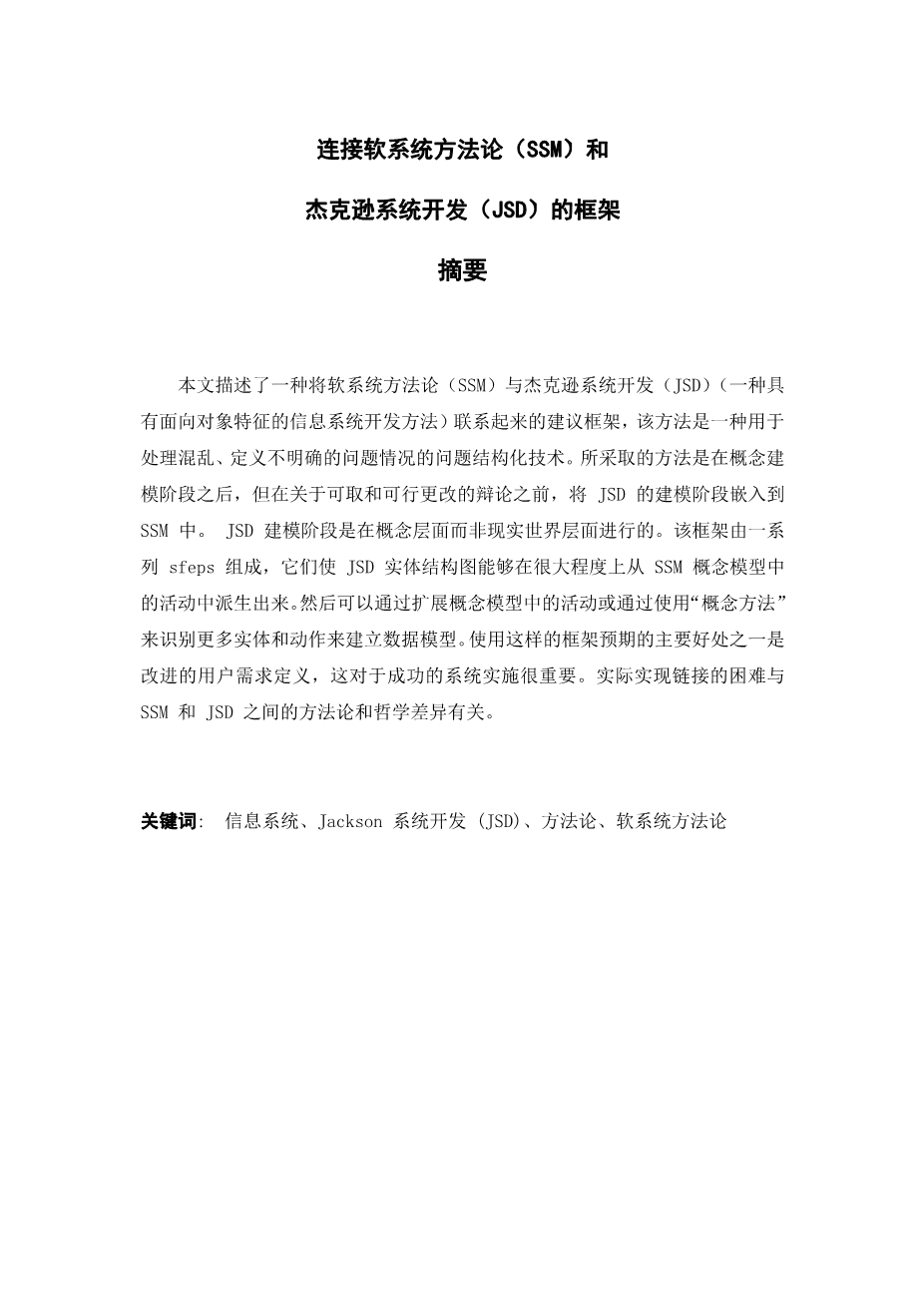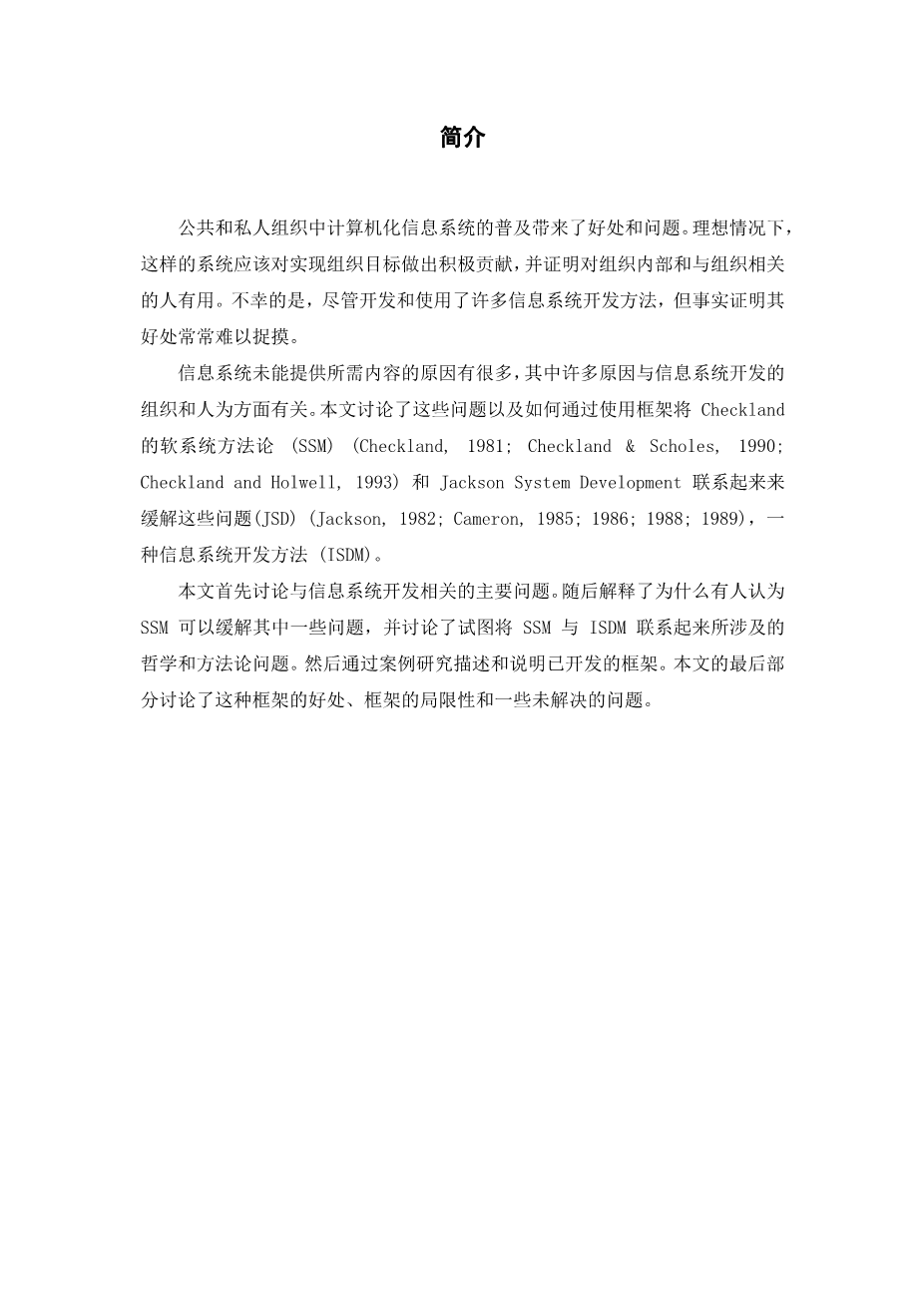A frameworLfor linking Soft Systems Methodology (SSM) and Jackson System Development(JSD)
Abstract
This paper describes a proposed framework for linking soft systems methodology (SSM), a problem structuring technique for use in messy, ill-defined problem situations, with Jackson System Development (JSD), an information system development methodology which has object-oriented characteristics. The approach taken has been to embed the modelling phase of JSD within SSM after the conceptual modelling stage, but before the debate on desirable and feasible change. The JSD modelling phase is carried out at a conceptual rather than a real world level. The framework comprises of a series of sfeps which enable JSD entity structure diagrams fo be derived to a large extent from the activities in an SSM conceptual model. A data model may then be built up by exploding the activities in the conceptual model or by using lsquo;conceptual howsrsquo; to identify more entities and actions. One of the main benefits expected fo arise from the use of such a framework is an improved user requirement definition, which is important to suc- cessful systems implementation. The difficulties in actually achieving a link relate to the methodological and philosophical differences between SSM and JSD.
Keywords Information systems, Jackson System Development (JSD), methodol- ogy, soft systems methodology
INTRUDUCTION
The proliferation of computerized information systems in both public and private organizations has brought both benefits and problems. Ideally, such systems should make a positive con- tribution to the achievement of organizational objectives and prove useful to those both within, and connected to, the organization. Unfortunately, despite the development and use of a number of information system development methodologies, the benefits have proved elusive all too often.
Several reasons have been cited for the failure of information systems to deliver what is required, with many reasons relating to organizational and human aspects of information systems development. This paper discusses these problems and the ways in which they might be alleviated by the use of a framework to link Checklandrsquo;s soft systems methodology (SSM) (Checkland, 1981; Checkland amp; Scholes, 1990; Checkland and Holwell, 1993) and Jackson System Development (JSD) (Jackson, 1982; Cameron, 1985; 1986; 1988; 1989), an informa- tion system development methodology (ISDM).
This paper starts by discussing the main problems which have been identified in relation to information systems development. This is followed by an explanation of why it is argued that SSM could alleviate some of these problems, and a discussion of philosophical and metho- dological issues involved in trying to link SSM with an ISDM. The framework that has been developed is then described and illustrated by a case study. The final sections of the paper discuss the benefits of such a framework, the limitations of the framework and some unresolved problems.
PROBLEMS RELATED TO THE USE OF INFORMATION SYSTEM DEVELOPMENT METHODOLOGIES
The common aim of ISDMs, whether process-oriented or data-focused, is to assist developers in successfully implementing information systems. The latter activity involves intervening in a human activity system. However, despite the greater importance of the human, rather than the technical aspects of an information system, the former receive far less attention from ISDMs than the latter (Galliers, 1987). It is this failure to address human and organizational issues which is considered to be part of the reason why so many computerized information systems fail (Jones, 1992). The importance of such issues is evident when the nature of an information system is considered.
An information system is more than a data processing system. Information has been defined as interpreted data, that is, data to which meaning has been attributed from a particular view- point (Checkland amp; Scholes, 1990). An information system should provide relevant and useful information about the organization and its environment to the users who can be defined as anyone who has an interest in the input and output of the information system. This information ought also to meet management needs for information to support organizational objectives. User dissatisfaction is an aspect of many computerized information systems, sometimes leading to users failing to make any use of the system, or even to the cancellation of the whole project (Mingers, 1995). One of the reasons for user dissatisfaction is the extreme difficulty which can be experienced in trying to identify userrsquo;s key information requirements. A reliance by many ISDMs on interviews, comments and documentation is not necessarily sufficient for identification of these needs. The lack of mechanisms or techniques within ISDMs for enabling users to express their information needs can prove serious because there is evidence that the more thoroughly information needs are defined at the outset, the more likely implementation is to be successful (Galliers, 1987). In addition, choices made at the beginning of a project are critical in determining the final version of a system (Stowell, 1985). However, insufficient time is often spent on the investigation stage of the systems life cycle.
At the heart of the failure of ISDMs to perform effective analysis is the assumption that the lsquo;...determination of a sirgle agreed model of ihe real world is a straight-forward activity (Wood amp; Doyle, 1989, p. 4) involving no disagreement among users. The focus is on trying to extract a single set of compatible user requirements rather than to explore, and understand, usersrsquo; requirements within a problem situation which might benefit from computerized support. The failure to ident
剩余内容已隐藏,支付完成后下载完整资料


英语译文共 10 页,剩余内容已隐藏,支付完成后下载完整资料
资料编号:[603422],资料为PDF文档或Word文档,PDF文档可免费转换为Word
课题毕业论文、外文翻译、任务书、文献综述、开题报告、程序设计、图纸设计等资料可联系客服协助查找。


